
How often do the words ‘good autumn colour’ seal your decision to ‘buy now’ when browsing a tree or shrub you hadn’t actually set out to purchase at all?
Don’t feel guilty. Trees that round off their summer performance with a blaze of glowing crimson give you twice as many bangs for your hard-earned bucks. And there’s something about the vibrancy of a flaming autumn leaf that isn’t quite captured in anything else during the year.
But which are the best to choose? In our view, there are some go-to trees and shrubs if you’re after an autumnal blaze……..

Thank heavens for autumn colour! A little compensation for saying goodbye to another summer forever. Prepare to don your sunglasses one more time…….
- The stag’s horn sumach (Rhus typhina) must be one of the best-known – its jagged leaves at this time of year would put a rainbow to shame in terms of colour palette. Just a ‘heads’ up’ though, it’s horrendous for producing suckers – have you noticed how you never see just one? Resolve to be ‘on this’, or simply admire it in other people’s gardens?
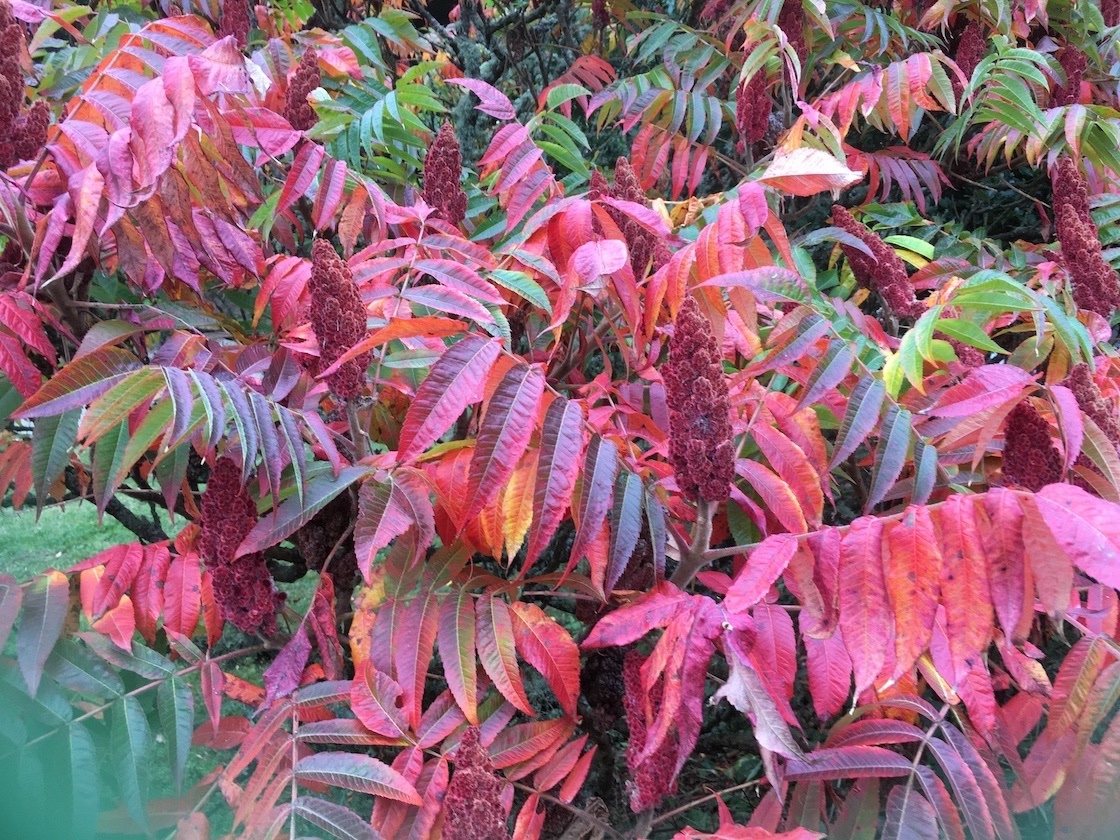
2. The Persian ironwood tree (Parrotia persica ) is a very hardy beauty and its October/November finery is a fabulous spectacle. It’s not a quick grower – could take more than 30 years to reach a max height of 8m – and could even be grown as a large shrub. It is wide-spreading though, which is rather wonderful because it can display that awesome leaf-colour to perfection.
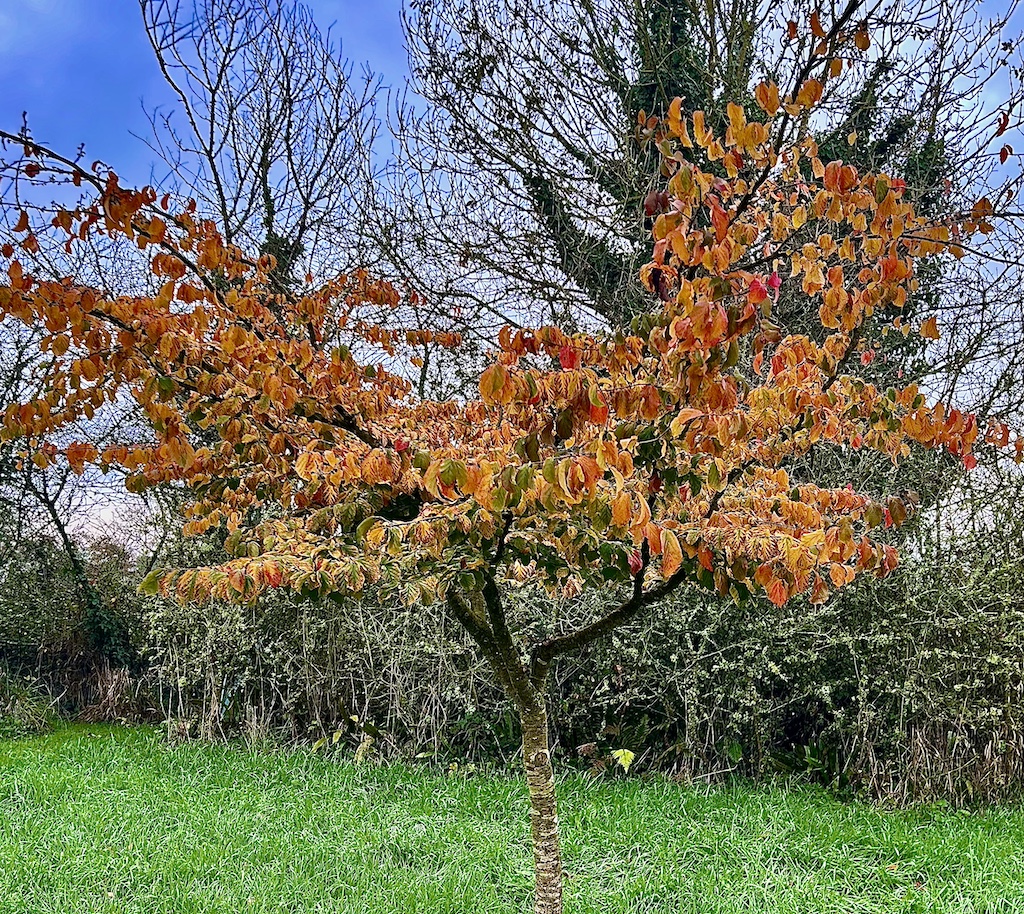
3. A medlar tree (Mespilus germanica) is a bit of a rarity these days. Maybe because its fruits taste like sweet mud and look like a cat’s bottom. Nevertheless, a medlar is a very pretty small tree to have in the garden in both spring and autumn… it’s that double ‘bang for your buck’ right there.

4. If you have plenty of space, how about Liquidambar styraciflua ‘Worplesdon’ ? It’s a eye-popping kaleidoscope in the autumn. My only caveat here would be that its branches are rather brittle so it’s not a tree for a windy spot.
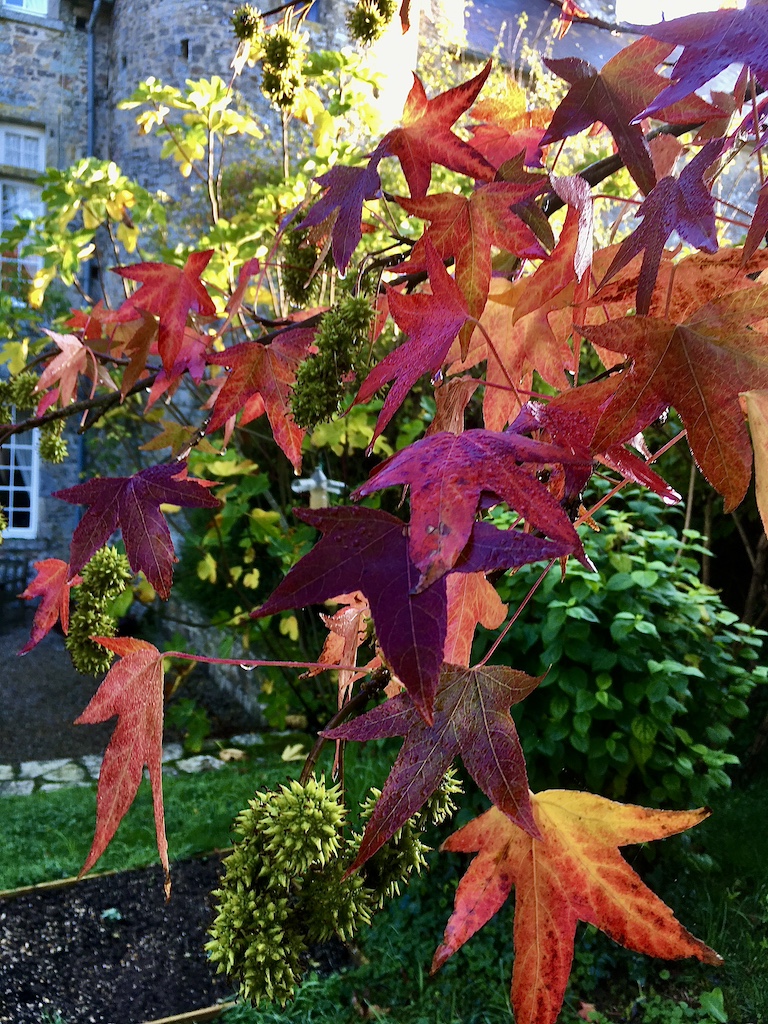
5. And if you want a truly extraordinary and unearthly picture, get a Callicarpa bodinieri ‘Profusion’. It’s hardy pretty much everywhere in the UK and its brilliant purple berries among the turning leaves are 100% guaranteed to blow your mind!
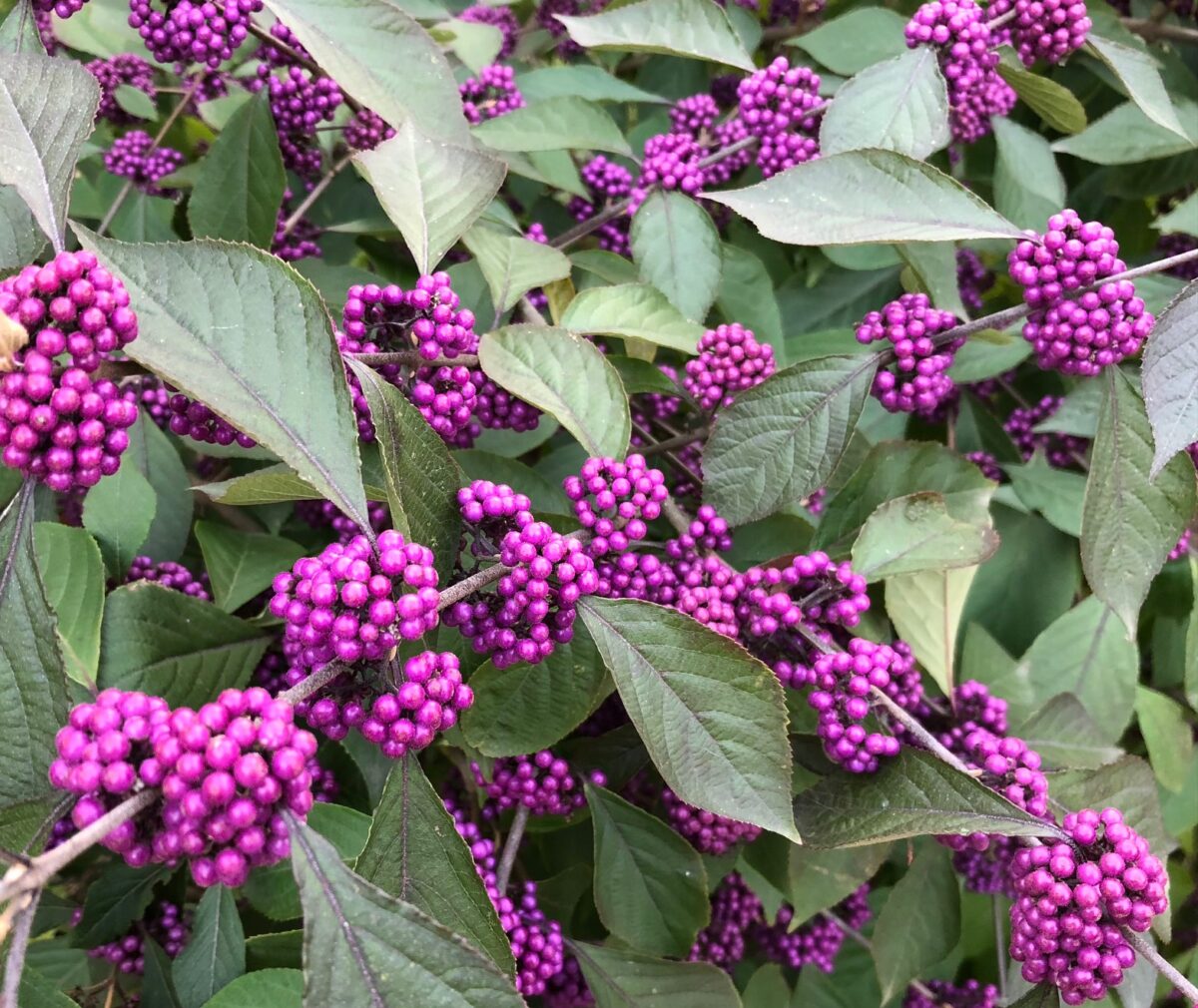

For botanists like us (I’m excluding Elaine and Caroline here for obvious reasons) autumn is an exciting time.
Millennia ago, deciduous trees took the evolutionary pathway of closing up shop for the winter, withdrawing green chlorophyll from their leaves when light levels dropped, and revealing background beige and yellow carotenes before falling off.
If the autumn is cool and damp, but not frosty, some tree taxa carry out further chemical recycling revealing those gorgeous red and orange compounds of anthocyanin, and this year’s weather pattern is shaping up nicely to make these colours particularly intense. So what trees will really pull out all the stops?
6. For me one of the most valuable contributors to the autumn
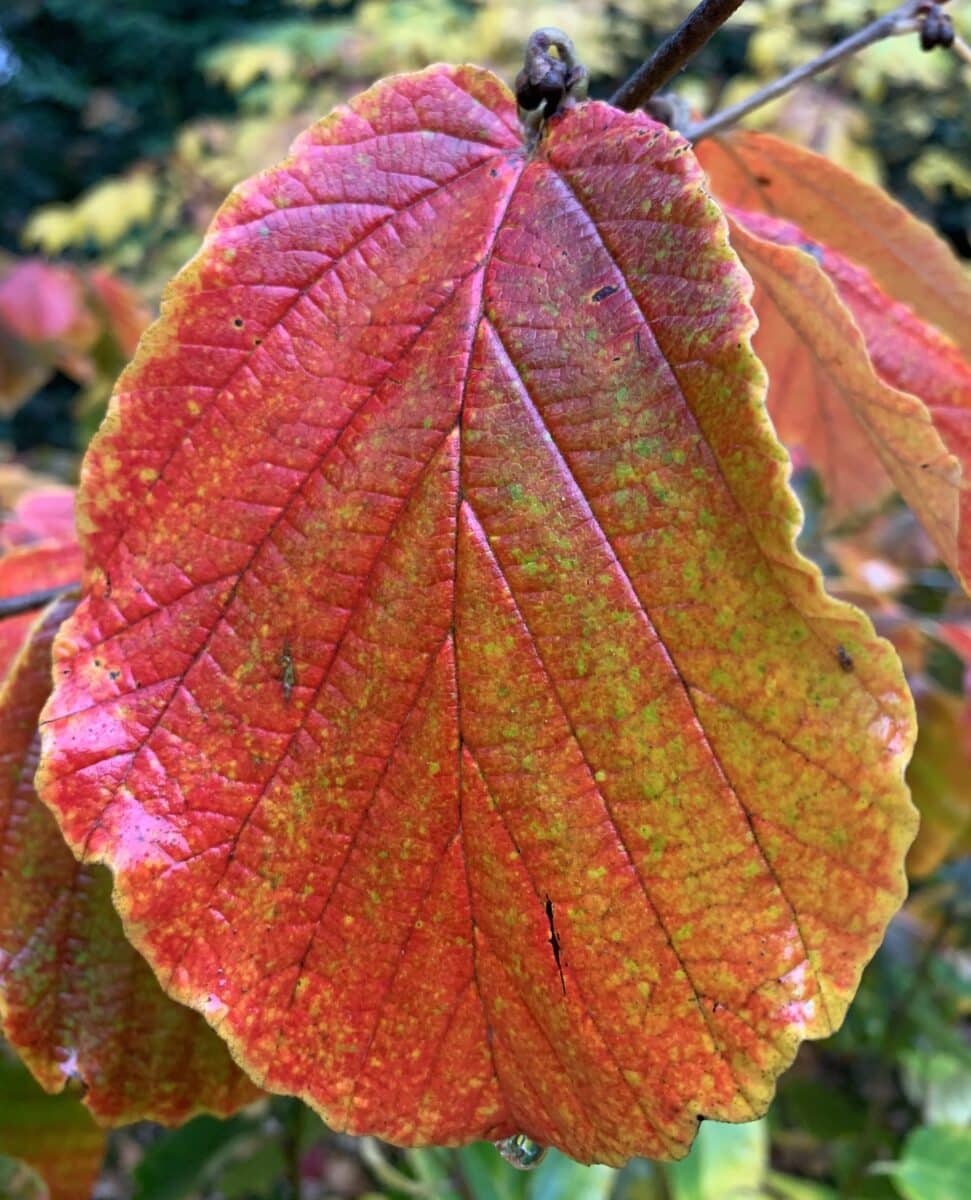
7. If you don’t have space for a spreading witch hazel (or a whopping great Parrotia – they can grow huge…) , try the smaller Fothergilla major. With me it has never missed putting on a fantastic autumn display since I planted it. It’s a neat little tree, which I grow mainly for its autumn colour so am delighted when I spot its sweet little cream flowers in spring like miniature bottlebrushs.
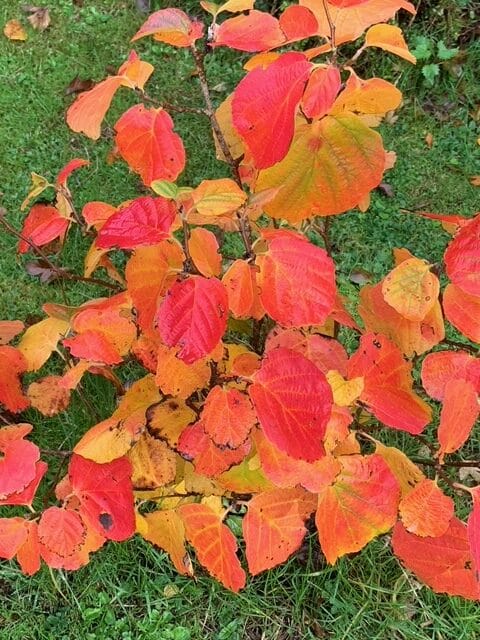
8. Another multi-purpose shrub would be the blueberry; blossom in spring, lovely fresh berries in summer and fiery reds and yellows in the autumn.
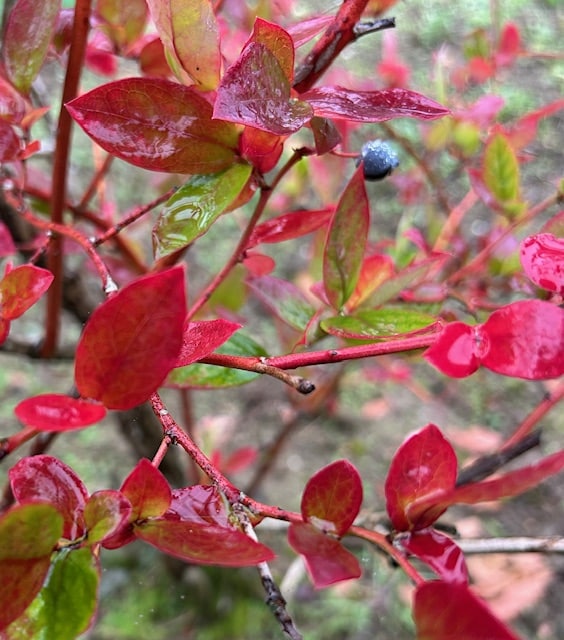
They belong to the genus Vaccinium, acid-loving berried bushes in the heather family, which all colour up well in the autumn. Knowing a native variety, known colloquially as ‘blaeberry’, grows well in the Highlands I asked Caroline to try and photograph a wild vaccinium a couple of years ago, and was slightly disappointed with her answer of ‘wot’s that then?’

Well a ‘vaccinium’ sounded like a flu jab to me 🤷♀️. Being the little sister of a horticultural/intellectual snob is very like being related to a Latin dictionary (BTW what does she mean by ‘tree taxa?’)
9. Here in the Highlands we might have small disappointments … midgies, short winter days (and don’t get me started on pylons and wind farms) but our acid soil does mean we have a profusion of fab-u-lous rowan trees both domesticated and wild, lighting up the landscape with red, yellow or pink berries and gorgeous leaves. Just look at this Sorbus ‘Joseph Rock’ up the lane from me.
Rowans are also reputed to ward off witches – something to consider at this time of year.
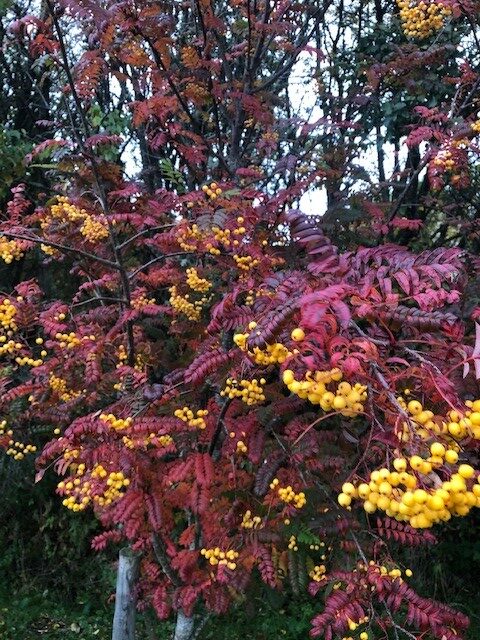
10. And E & L won’t mention them, I think they feel they’re passé, but acers – particularly small ones planted alongside ornamental grasses and hesperanthus or rudbekia, are ‘cover girl’ gorgeous in the autumn (see our feature pic). The flaming reds and golds of these Japanese maples are bringing Hollywood-level drama to just about every (sheltered) UK garden right now. Lovely little trees.
11. You can’t exclude deciduous azaleas from this topic. If the medley of their different varieties planted together gives you a migraine in spring (I’m talking directly to old grumps Laura here), opt for A. Luteum. There is a bit of ‘old money’ about this one with its earthy spring scent and knock-out autumn colour. Much loved by the aristocracy and that should include you.
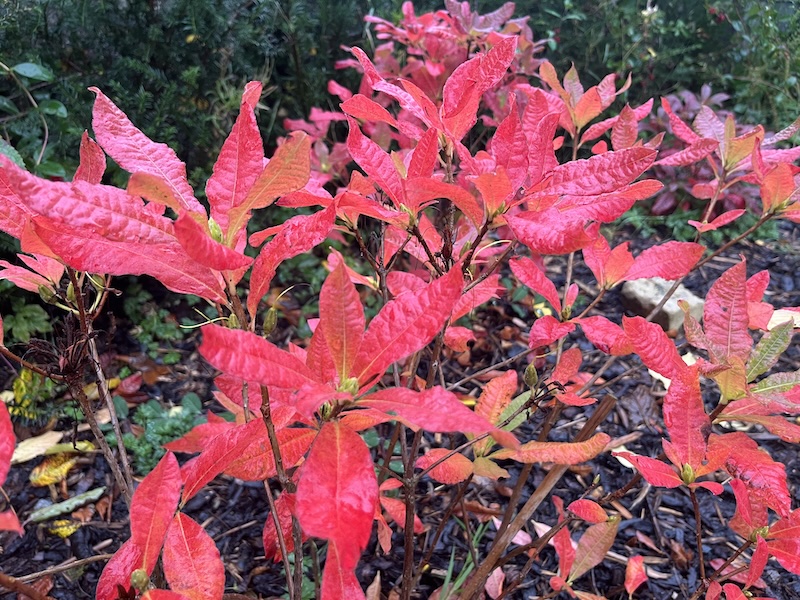
12. And finally, if you also live in Scotland/have an acid soil you really should have an Aronia in your
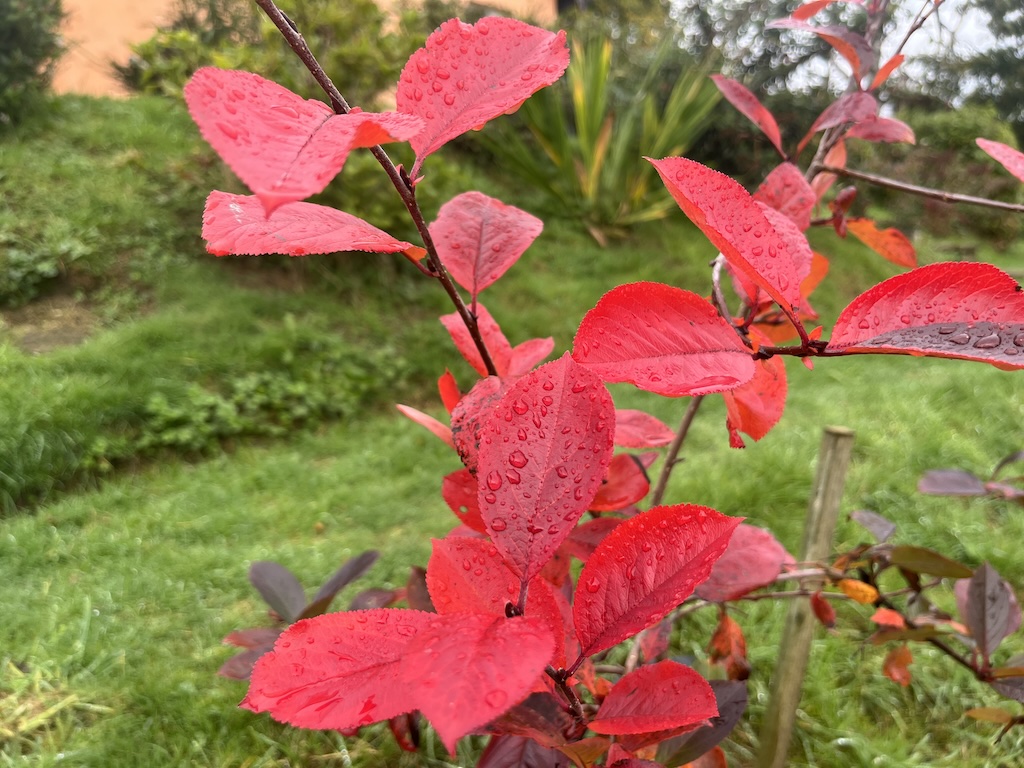
Would all of these be on your list? Are there any we’ve missed in your opinion? We’d really love to know. We are all too willing to press that irresponsible ‘buy now’ button.
You can buy pretty much all the trees and shrubs in this post here. (Remember to check what growing conditions each would need – some of the autumn beauties are a little fussy!) :
How far is too far to travel to buy a plant you really want? For Louise it was quite a long way to snaffle this very special autumn beauty, which is why it’s her Great Plant of the Month:
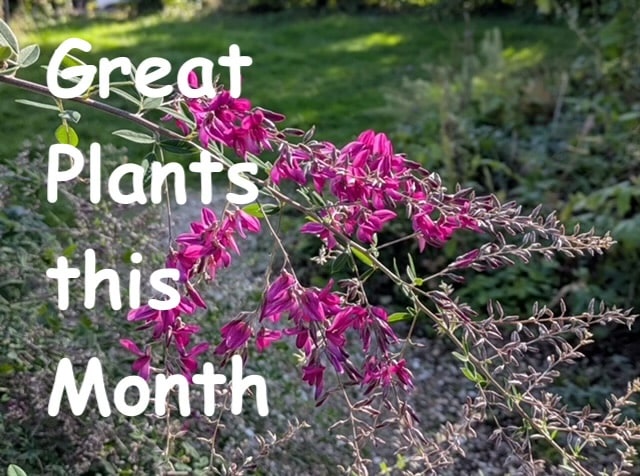
Laura and Louise are both off to the Great Dixter Autumn Plant Fair tomorrow, to read about a previous outing to this colourful event, click on the picture below;

💚 The costs of keeping our site working and safe are going up. We want to go on sharing everything for free without adverts, but if you enjoy our weekly posts, the price of a cup of coffee would be extremely helpful in paying the bills! Thank you 💚
NB If you’re not already a subscriber and you’d like a bit more gardening chitchat from the3growbags, please type your email address here and we’ll send you a new post every Saturday morning.

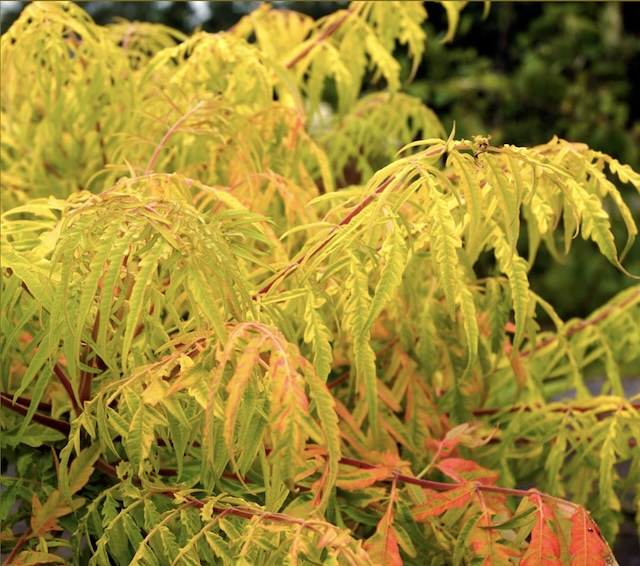
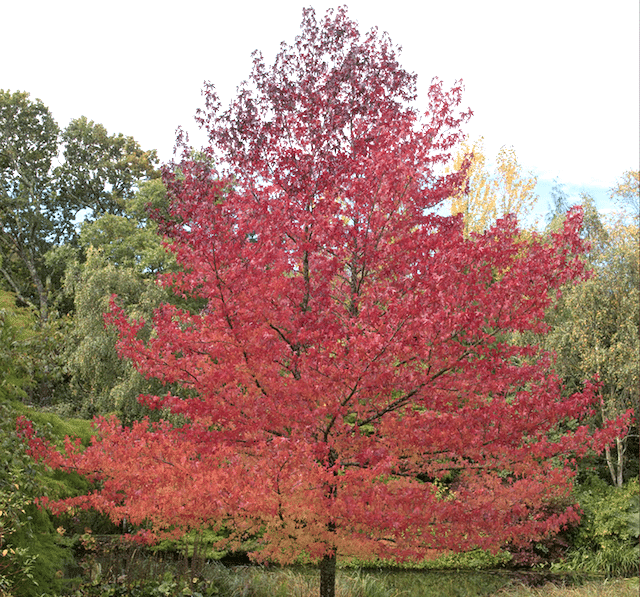
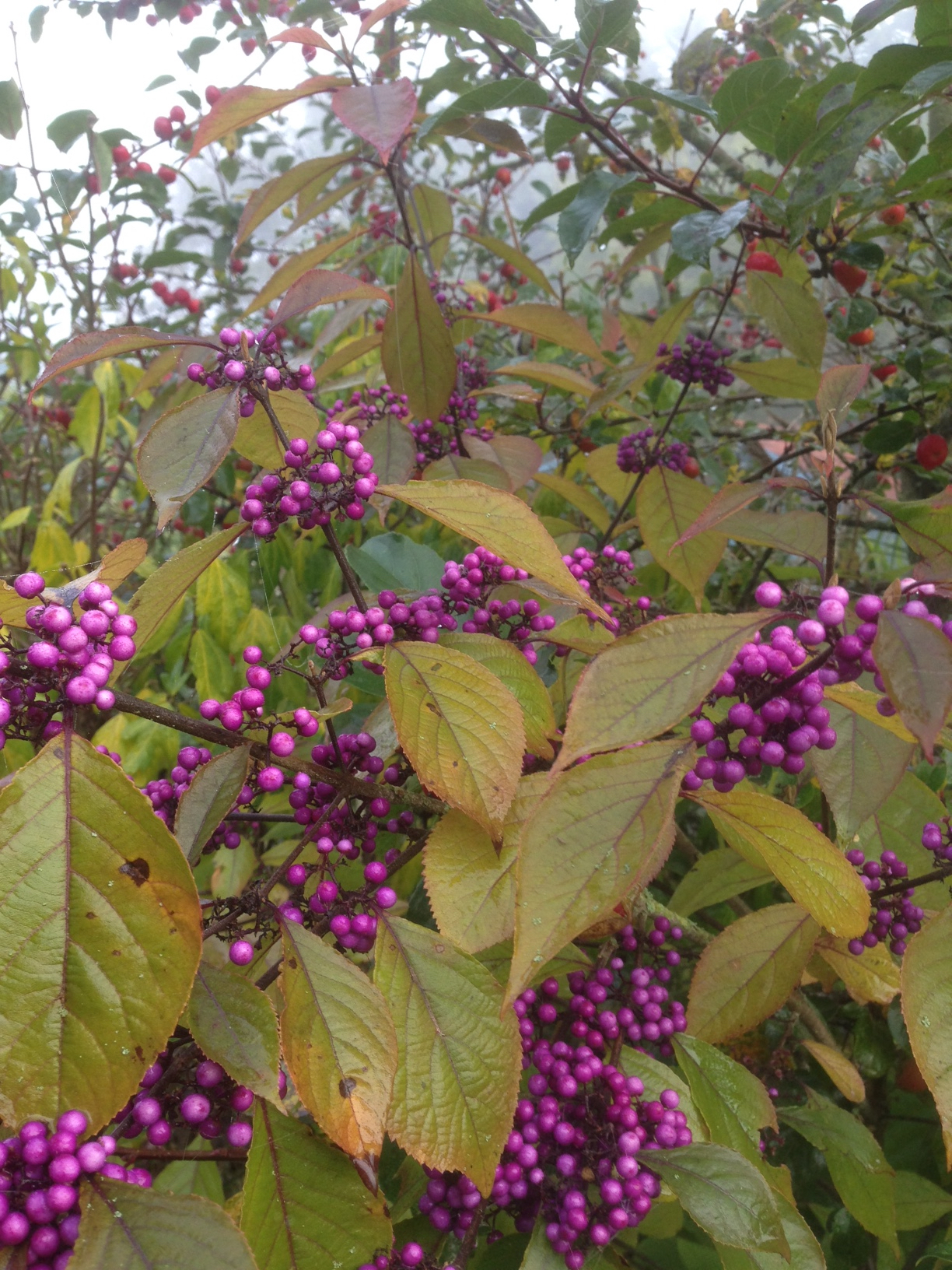
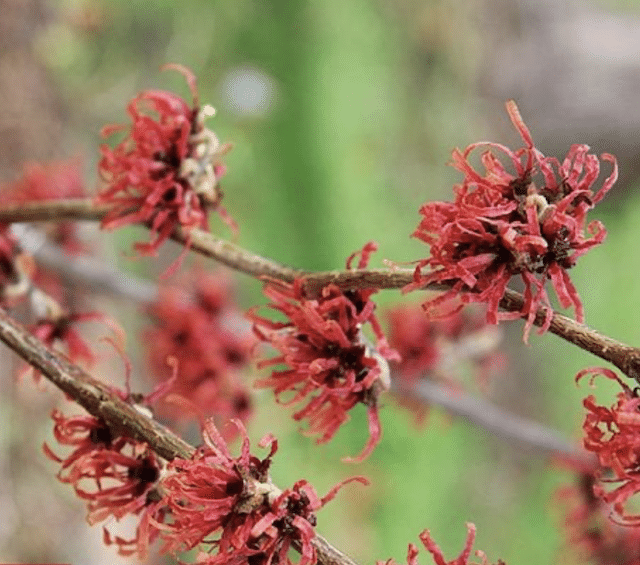
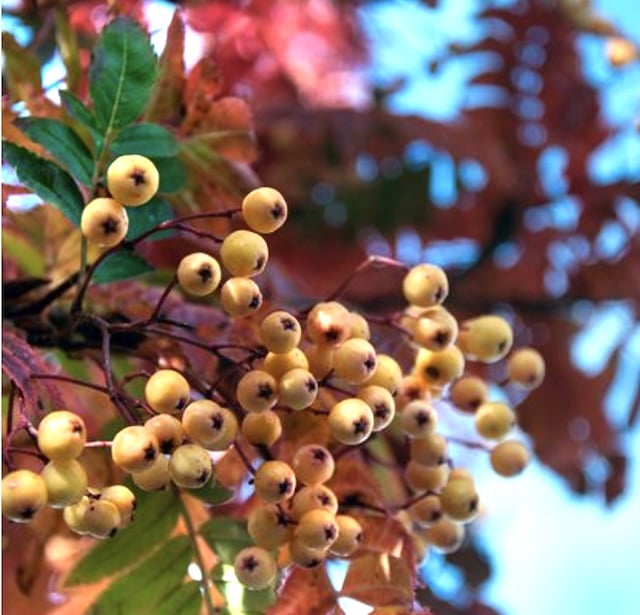
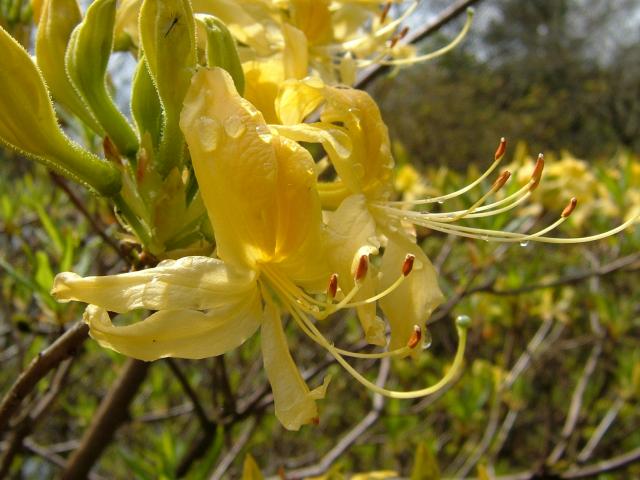
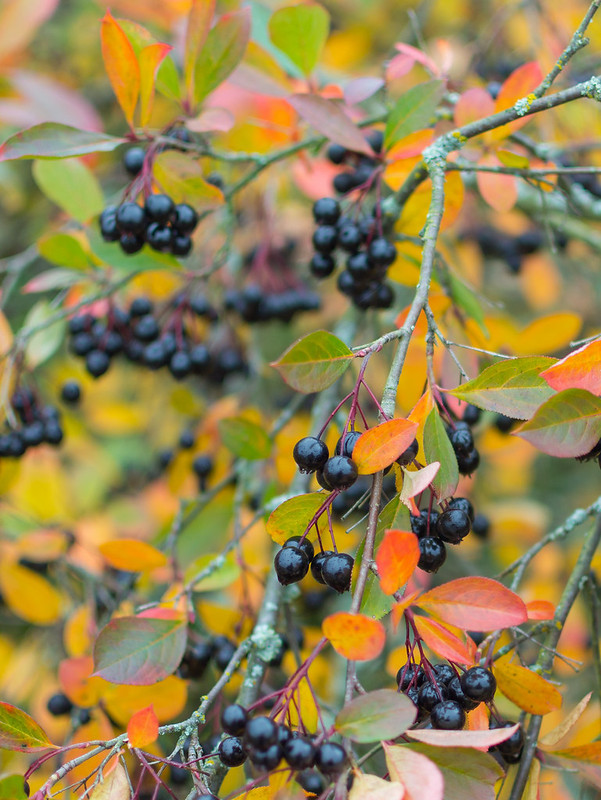
12 replies on “Autumn colour: Our top 12 trees and shrubs”
Amelanchier lamarckii puts on a good show in the autumn and also has pretty white flowers in the spring. The berries are meant to be good too but the birds eat them immediately in my garden so I don’t get to see them for long!
Hi Sarah, I’ve got this pretty tree too, and you’re right, it’s lovely in spring because the new rust-coloured leaf shoots look gorgeous among the white blossom and then again in autumn. Nope, I’ve never seen berries on mine either – as with the mulberry tree, the avian population must simply lie in wait for the very moment the fruit is ripe and delish! Enjoy your autumn garden, Elaine (and the other two….)
Love all your suggestions.
I have some of them, but don’t forget the Cercidphylum…the burnt sugar tree.
Mine is beyond fabulous at the moment and a great tree for a small garden.
Hi Ishbel, Ooooh yes, we missed that one out, didn’t we! You’re right, it is a wonderful garden tree; I was looking round a garden recently with a group of people, and that amazing (and delicious!) caramel scent was wafting around us as we wandered through to find the source. Theirs was a pretty big tree – I think they’d had it about 20 years – but I agree that because it grows fairly slowly, it doesn’t need masses of space. Thank you so much for writing in, all the best, Elaine.
I’ve planted a Parrotia Persica in what will be the wrong place in a few years so was interested to see you say it could be a bush. Mine is now about 8 ft – is that too late to trim/ prune it back?
Hi Caroline, No, not too late at all, in my opinion. The thing about Parrotia is that the trunk is actually quite short and it’s the spreading branches that make it a wide and large shrub or tree. I think it would be a mistake to give it a hard prune at any time, because that would spoil the lovely drooping natural shape of the plant. But if you carefully take out some of the top, crossing, dead or diseased branches quite regularly, in late winter or very early spring (to avoid leaking sap), I think you should be able to keep it to a manageable size and shape for many years to come. Good luck! All the best, Elaine
How about Euonymus alatus?That is a good bet for someone after colour.The Acer japonicum also has beautiful red wood after leaf fall that I think is lovely.This year I have a spectacular Pear tree which is scarlet and almost plum shades and below it but some distance away some Gillenia trifoliata which is trying to match it as the season progresses!
Hello David, as I read through your suggestions I kept saying a big Yes! as I also have several of these in my garden. The euonymus alata you mention goes the brightest red I have ever seen in a garden plant, whilst the gillenia is much more nuanced. Sadly I don’t have a pear tree to match yours though! Acers really come into their own at this time of the year don’t they, superb foliage and then the winter bark. Mine is a snakeskin variety with green and white striations. Thanks for writing in to remind us and our readers of these great autumn performers. Best wishes Laura
Prunus incisa ‘Kojo-no-mai
This has three seasons of interest. First is that it covers itself with many white flowers in the spring. Secondly, its leaves turn a glowing gold in the autumn. Then,in the winter, it zig -zag twiggy branches make it an attractive feature, especially when covered in snow. Ideal for Caroline’s garden.
Hello Bill, Laura here and I couldn’t agree more about this wonderful little cherry tree. It’s a fantastic all rounder that fits nicely into the smallest garden. You’ll be very pleased to hear that I bought one down south in a summer sale and took it up as a gift for Caroline when I went to the Highlands to help with her Open Garden weekend in August – great minds think alike! Best wishes Laura
Rhus Typhina is a NIGHTMARE! My neighbour planted one along the fence of our detached houses – SHE now has 5x and counting – WE have babies pushing up everywhere, including ones 20ft from the original. The council dug up a huge root, pushing up the public path, that was easy 5″ thick. Said she was lucky not to get charged for the work!
Hello Marie, yes it’s got that reputation hasn’t it – such a shame as it’s a gorgeous shrub. Interestingly, it was a topic of discussion on the last Gardeners Question Time on radio 4 and Matthew Pottage reckons that it’s any sort of disturbance to the root that makes it sucker, and that he has known specimens that just remain in their allotted planting hole for 20 years, so long as you don’t damage any of the root system. So it’s a Catch 22 – if you try to dig them out they just spread even more!
Think you have to follow every single root sucker back and get it out to completely eradicate it …. Thanks for giving us and our readers this cautionary tale. Best wishes Laura